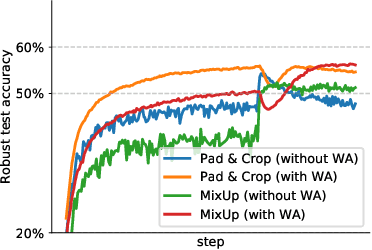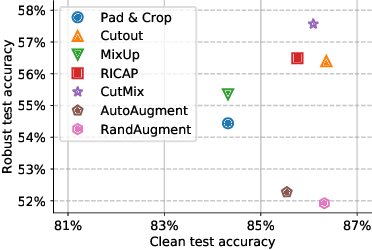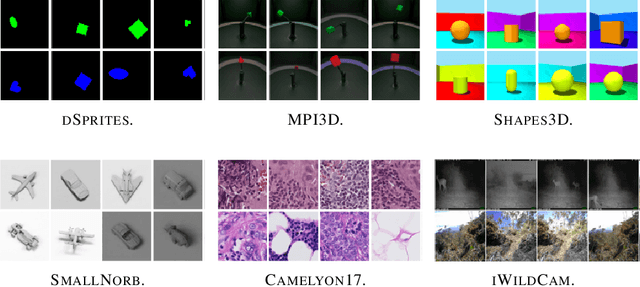Olivia Wiles
Dj
Imagen 3
Aug 13, 2024Abstract:We introduce Imagen 3, a latent diffusion model that generates high quality images from text prompts. We describe our quality and responsibility evaluations. Imagen 3 is preferred over other state-of-the-art (SOTA) models at the time of evaluation. In addition, we discuss issues around safety and representation, as well as methods we used to minimize the potential harm of our models.
Evaluating Model Bias Requires Characterizing its Mistakes
Jul 15, 2024



Abstract:The ability to properly benchmark model performance in the face of spurious correlations is important to both build better predictors and increase confidence that models are operating as intended. We demonstrate that characterizing (as opposed to simply quantifying) model mistakes across subgroups is pivotal to properly reflect model biases, which are ignored by standard metrics such as worst-group accuracy or accuracy gap. Inspired by the hypothesis testing framework, we introduce SkewSize, a principled and flexible metric that captures bias from mistakes in a model's predictions. It can be used in multi-class settings or generalised to the open vocabulary setting of generative models. SkewSize is an aggregation of the effect size of the interaction between two categorical variables: the spurious variable representing the bias attribute and the model's prediction. We demonstrate the utility of SkewSize in multiple settings including: standard vision models trained on synthetic data, vision models trained on ImageNet, and large scale vision-and-language models from the BLIP-2 family. In each case, the proposed SkewSize is able to highlight biases not captured by other metrics, while also providing insights on the impact of recently proposed techniques, such as instruction tuning.
Evaluating Numerical Reasoning in Text-to-Image Models
Jun 20, 2024



Abstract:Text-to-image generative models are capable of producing high-quality images that often faithfully depict concepts described using natural language. In this work, we comprehensively evaluate a range of text-to-image models on numerical reasoning tasks of varying difficulty, and show that even the most advanced models have only rudimentary numerical skills. Specifically, their ability to correctly generate an exact number of objects in an image is limited to small numbers, it is highly dependent on the context the number term appears in, and it deteriorates quickly with each successive number. We also demonstrate that models have poor understanding of linguistic quantifiers (such as "a few" or "as many as"), the concept of zero, and struggle with more advanced concepts such as partial quantities and fractional representations. We bundle prompts, generated images and human annotations into GeckoNum, a novel benchmark for evaluation of numerical reasoning.
Revisiting Text-to-Image Evaluation with Gecko: On Metrics, Prompts, and Human Ratings
Apr 25, 2024Abstract:While text-to-image (T2I) generative models have become ubiquitous, they do not necessarily generate images that align with a given prompt. While previous work has evaluated T2I alignment by proposing metrics, benchmarks, and templates for collecting human judgements, the quality of these components is not systematically measured. Human-rated prompt sets are generally small and the reliability of the ratings -- and thereby the prompt set used to compare models -- is not evaluated. We address this gap by performing an extensive study evaluating auto-eval metrics and human templates. We provide three main contributions: (1) We introduce a comprehensive skills-based benchmark that can discriminate models across different human templates. This skills-based benchmark categorises prompts into sub-skills, allowing a practitioner to pinpoint not only which skills are challenging, but at what level of complexity a skill becomes challenging. (2) We gather human ratings across four templates and four T2I models for a total of >100K annotations. This allows us to understand where differences arise due to inherent ambiguity in the prompt and where they arise due to differences in metric and model quality. (3) Finally, we introduce a new QA-based auto-eval metric that is better correlated with human ratings than existing metrics for our new dataset, across different human templates, and on TIFA160.
Generative models improve fairness of medical classifiers under distribution shifts
Apr 18, 2023Abstract:A ubiquitous challenge in machine learning is the problem of domain generalisation. This can exacerbate bias against groups or labels that are underrepresented in the datasets used for model development. Model bias can lead to unintended harms, especially in safety-critical applications like healthcare. Furthermore, the challenge is compounded by the difficulty of obtaining labelled data due to high cost or lack of readily available domain expertise. In our work, we show that learning realistic augmentations automatically from data is possible in a label-efficient manner using generative models. In particular, we leverage the higher abundance of unlabelled data to capture the underlying data distribution of different conditions and subgroups for an imaging modality. By conditioning generative models on appropriate labels, we can steer the distribution of synthetic examples according to specific requirements. We demonstrate that these learned augmentations can surpass heuristic ones by making models more robust and statistically fair in- and out-of-distribution. To evaluate the generality of our approach, we study 3 distinct medical imaging contexts of varying difficulty: (i) histopathology images from a publicly available generalisation benchmark, (ii) chest X-rays from publicly available clinical datasets, and (iii) dermatology images characterised by complex shifts and imaging conditions. Complementing real training samples with synthetic ones improves the robustness of models in all three medical tasks and increases fairness by improving the accuracy of diagnosis within underrepresented groups. This approach leads to stark improvements OOD across modalities: 7.7% prediction accuracy improvement in histopathology, 5.2% in chest radiology with 44.6% lower fairness gap and a striking 63.5% improvement in high-risk sensitivity for dermatology with a 7.5x reduction in fairness gap.
Differentially Private Diffusion Models Generate Useful Synthetic Images
Feb 27, 2023



Abstract:The ability to generate privacy-preserving synthetic versions of sensitive image datasets could unlock numerous ML applications currently constrained by data availability. Due to their astonishing image generation quality, diffusion models are a prime candidate for generating high-quality synthetic data. However, recent studies have found that, by default, the outputs of some diffusion models do not preserve training data privacy. By privately fine-tuning ImageNet pre-trained diffusion models with more than 80M parameters, we obtain SOTA results on CIFAR-10 and Camelyon17 in terms of both FID and the accuracy of downstream classifiers trained on synthetic data. We decrease the SOTA FID on CIFAR-10 from 26.2 to 9.8, and increase the accuracy from 51.0% to 88.0%. On synthetic data from Camelyon17, we achieve a downstream accuracy of 91.1% which is close to the SOTA of 96.5% when training on the real data. We leverage the ability of generative models to create infinite amounts of data to maximise the downstream prediction performance, and further show how to use synthetic data for hyperparameter tuning. Our results demonstrate that diffusion models fine-tuned with differential privacy can produce useful and provably private synthetic data, even in applications with significant distribution shift between the pre-training and fine-tuning distributions.
Compressed Vision for Efficient Video Understanding
Oct 06, 2022



Abstract:Experience and reasoning occur across multiple temporal scales: milliseconds, seconds, hours or days. The vast majority of computer vision research, however, still focuses on individual images or short videos lasting only a few seconds. This is because handling longer videos require more scalable approaches even to process them. In this work, we propose a framework enabling research on hour-long videos with the same hardware that can now process second-long videos. We replace standard video compression, e.g. JPEG, with neural compression and show that we can directly feed compressed videos as inputs to regular video networks. Operating on compressed videos improves efficiency at all pipeline levels -- data transfer, speed and memory -- making it possible to train models faster and on much longer videos. Processing compressed signals has, however, the downside of precluding standard augmentation techniques if done naively. We address that by introducing a small network that can apply transformations to latent codes corresponding to commonly used augmentations in the original video space. We demonstrate that with our compressed vision pipeline, we can train video models more efficiently on popular benchmarks such as Kinetics600 and COIN. We also perform proof-of-concept experiments with new tasks defined over hour-long videos at standard frame rates. Processing such long videos is impossible without using compressed representation.
Discovering Bugs in Vision Models using Off-the-shelf Image Generation and Captioning
Aug 18, 2022



Abstract:Automatically discovering failures in vision models under real-world settings remains an open challenge. This work demonstrates how off-the-shelf, large-scale, image-to-text and text-to-image models, trained on vast amounts of data, can be leveraged to automatically find such failures. In essence, a conditional text-to-image generative model is used to generate large amounts of synthetic, yet realistic, inputs given a ground-truth label. Misclassified inputs are clustered and a captioning model is used to describe each cluster. Each cluster's description is used in turn to generate more inputs and assess whether specific clusters induce more failures than expected. We use this pipeline to demonstrate that we can effectively interrogate classifiers trained on ImageNet to find specific failure cases and discover spurious correlations. We also show that we can scale the approach to generate adversarial datasets targeting specific classifier architectures. This work serves as a proof-of-concept demonstrating the utility of large-scale generative models to automatically discover bugs in vision models in an open-ended manner. We also describe a number of limitations and pitfalls related to this approach.
Data Augmentation Can Improve Robustness
Nov 09, 2021



Abstract:Adversarial training suffers from robust overfitting, a phenomenon where the robust test accuracy starts to decrease during training. In this paper, we focus on reducing robust overfitting by using common data augmentation schemes. We demonstrate that, contrary to previous findings, when combined with model weight averaging, data augmentation can significantly boost robust accuracy. Furthermore, we compare various augmentations techniques and observe that spatial composition techniques work the best for adversarial training. Finally, we evaluate our approach on CIFAR-10 against $\ell_\infty$ and $\ell_2$ norm-bounded perturbations of size $\epsilon = 8/255$ and $\epsilon = 128/255$, respectively. We show large absolute improvements of +2.93% and +2.16% in robust accuracy compared to previous state-of-the-art methods. In particular, against $\ell_\infty$ norm-bounded perturbations of size $\epsilon = 8/255$, our model reaches 60.07% robust accuracy without using any external data. We also achieve a significant performance boost with this approach while using other architectures and datasets such as CIFAR-100, SVHN and TinyImageNet.
A Fine-Grained Analysis on Distribution Shift
Oct 21, 2021



Abstract:Robustness to distribution shifts is critical for deploying machine learning models in the real world. Despite this necessity, there has been little work in defining the underlying mechanisms that cause these shifts and evaluating the robustness of algorithms across multiple, different distribution shifts. To this end, we introduce a framework that enables fine-grained analysis of various distribution shifts. We provide a holistic analysis of current state-of-the-art methods by evaluating 19 distinct methods grouped into five categories across both synthetic and real-world datasets. Overall, we train more than 85K models. Our experimental framework can be easily extended to include new methods, shifts, and datasets. We find, unlike previous work~\citep{Gulrajani20}, that progress has been made over a standard ERM baseline; in particular, pretraining and augmentations (learned or heuristic) offer large gains in many cases. However, the best methods are not consistent over different datasets and shifts.
 Add to Chrome
Add to Chrome Add to Firefox
Add to Firefox Add to Edge
Add to Edge